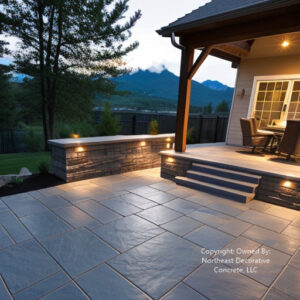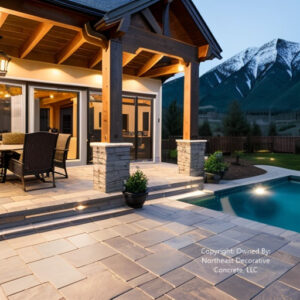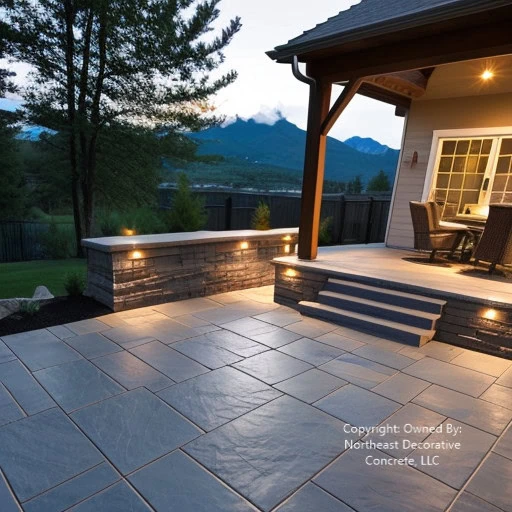
Understanding Stamped Concrete Mix Designs for Weather
New Hampshire’s weather is a rollercoaster. Summers can be blistering, while winters are frigid. You can expect everything in between. For concrete pros, this means making mixes that can resist temperature changes and freezing. They must also withstand rapid hydration. Let’s explore the science and tips for making durable concrete in the Granite State.
Key Takeaways
-
Winter Wisdom:
-
Use Type III cement + accelerators for -10°F pours.
-
Maintain a concrete temperature of 55°F with heated aggregates.
-
-
Summer Savvy:
-
Opt for 40% slag mixes to delay the set in 90°F heat.
-
Mist slabs hourly to combat NH’s 70% humidity drops.
-
-
Year-Round Rule:
-
Test air content daily—6% for winter, 4–5% for summer.
-
By mastering these concrete driveway mix design details, NH crews can withstand temperature extremes and make durable concrete one pour at a time.

Why Climates Demand Special Concrete Mixes
Concrete is like a living organism: it needs the right environment to thrive.
In NH, two main factors dictate mixed scenarios:
-
Freeze-Thaw Cycles: Water expands by 9% when frozen. Without proper air pockets, this pressure cracks concrete.
-
Temperature Extremes: Cold slows hydration, hurting strength. Heat speeds it, risking ruptures.
NH & MA mixes need air entrainment. It protects against freezing and controls the curing temperature.
Anatomy of an Optimized Stamped Concrete Mix
| Component | Role in NH Mixes | Cold Weather Adjustments |
|---|---|---|
| Cement | Binds materials; generates heat | Use Type III (high early strength) |
| Aggregates | Provide structure; reduce shrinkage | Pre-warm to 50–70°F |
| Water | Activates cement | Heat to 140–180°F (prevents freezing) |
| Admixtures | Enhance performance | Accelerators, air entrainers, antifreeze |
Pro Tips for Cold Weather Concrete Contractors:
-
Mix warmer: Aim for a concrete temperature of 55–75°F at placement.
-
Accelerate wisely: Use non-chloride accelerators like calcium nitrate. They speed up the setting and avoid risks of concrete sealer corrosion.
Cold Weather Concreting: A Step-by-Step Guide
1. Pre-Pour Prep
-
Heat aggregates: Store sand/gravel indoors or use ground heaters.
-
Use hot water: 160°F water raises the mix temperature without damaging the cement.
2. Mix Design Tweaks
-
Boost cement: 7–10% extra cement compensates for slow strength gain.
-
Air-entrainment: 6% air content resists freeze-thaw damage.
3. Pouring & Curing
-
Check ground temp: >32°F to prevent interfacial freezing.
-
Insulate immediately: Use thermal blankets for 72 or more hours.
Rochester Sidewalk Replacement
-
Conditions: 29°F, 25–30 mph winds.
-
Mix: Antifreeze admixtures + 65°F initial temp.
-
Result: No cracking despite temps dropping to 15°F post-pour.
Summer Decorative Concrete Patio Mix Adjustments
| Challenge | Solution |
|---|---|
| Rapid evaporation | Add hydration stabilizers (e.g., lignin) |
| Thermal cracking | Use low-heat cement (Type IV) |
| Plastic shrinkage | Mist slabs with water during placement |
Pro Tip: Pour at dawn/dusk to avoid peak heat.

Cold-Weather vs. Warm-Weather Concrete Mix Designs
Concrete isn’t a one-size-fits-all material. In New Hampshire, temperature swings demand tailored approaches. Let’s break down how cold- and warm-weather mixes differ. And why these adjustments matter for durability.
Temperature Thresholds: When to Switch Strategies
| Condition | Cold-Weather Threshold | Warm-Weather Threshold |
|---|---|---|
| Definition | Air temp ≤40°F during curing | Air temp ≥90°F |
| Critical Risks | Early freezing, slow strength gain | Rapid evaporation, thermal cracking |
| Ideal Placement Temp | 55°F (thin sections) – 40°F (massive) | Below 90°F to prevent slump loss |
NH contractors track weather and rain forecasts closely—mixes change when temps cross 40°F or 90°F.
Cement & SCMs: The Thermal Balancing Act
Cold-Weather Mixes
-
More cement: +7–10% Type III cement for rapid heat generation.
-
Less SCMs: Fly ash/slag limited to <15% to avoid delayed setting.
Warm-Weather Mixes
-
Less cement: Reduced cement lowers hydration heat.
-
More SCMs: 30–50% fly ash/slag slows set and cuts thermal stress.
A Rochester, NH, bridge deck (July 2024) used 40% slag to prevent damages during a 95°F pour.
Admixtures: Accelerators vs. Retarders
| Purpose | Cold-Weather Solutions | Warm-Weather Solutions |
|---|---|---|
| Set Time Control | Calcium nitrate accelerators | Lignin-based retarders |
| Workability | Air-entertainers (6% air) | High-range water reducers |
| Durability | Antifreeze agents (ethylene glycol) | Hydration stabilizers |
Pro Tip: Add accelerators late in the pour to offset cooling mix water in cold weather.
Aggregate & Water Adjustments
| Component | Cold-Weather Prep | Warm-Weather Prep |
|---|---|---|
| Aggregates | Heated to 50–70°F | Cooled with sprinklers/shade |
| Mixing Water | Warmed to 160°F | Chilled or ice-added |
| Slump | ≤5″ to reduce bleed water | Higher slump with superplasticizers |
Carroll Concrete preheats granite aggregates to 60°F for winter footings.
Curing & Protection: Opposing Strategies
Cold Weather
-
Insulation: Thermal blankets hold heat for 72+ hours.
-
Moisture Control: Seal with polyethylene to prevent drying.
Warm Weather
-
Evaporation Barriers: Spray curing compounds immediately.
-
Fogging: Misting slabs maintains 80% humidity.
Disaster Averted: In 2023, a patio pour happened in Portsmouth at 95°F. To prevent cracks, they used misting and white curing blankets.
Colored Concrete Strength Development Timelines
| Age | Cold-Weather Strength (psi) | Warm-Weather Strength (psi) |
|---|---|---|
| 24 Hours | 500–1,000 (with accelerators) | 2,000–3,000 |
| 28 Days | 4,000–5,000 | 3,500–4,500 (lower ultimate strength) |
Warm-weather mixes gain strength faster but lacks durability without proper controls.
Stamped Concrete Cost & Sustainability Factors
| Factor | Cold-Weather Impact | Warm-Weather Impact |
|---|---|---|
| Energy Use | High (aggregate heating, enclosures) | Moderate (cooling systems) |
| CO₂ Emissions | +10–15% (extra cement) | -20% (high SCM mixes) |
| Labor Hours | +30% (slow finishing) | -25% (faster set) |
Holcim’s ECOPact mixes with 50% slag, cutting summer CO₂ by 18% vs. winter blends.
The Stamped Concrete Patio Supplier Landscape
Local ready-mix companies tailor mixes for regional conditions.
| Supplier | Specialty Mixes | Service Area |
|---|---|---|
| Carroll Concrete | 4,000+ PSI winter blends | NH, VT |
| Redimix Companies | Air-entrained highway concrete | Southern NH, ME |
| Coleman Concrete | 5000+ PSI all-season mixes | Northern New England |
Carroll’s “ArcticMix” uses Type III cement + nano-silica for -10°F pours.
Standard Mix Designs (PSI Ratings)
| Application | Mix Design | Key Additives |
|---|---|---|
| Driveways | 4,000 PSI, 6% air | Fiber reinforcement |
| Foundations | 5,000 PSI, moderate slump | Water reducers |
| Decorative patios | 3,000 PSI, high-flow | Integral color |
Warning: Avoid >5% fly ash in winter—it delays setting.
When Disaster Strikes: Fixing Cold Weather Failures
Problem: Surface scaling
-
Cause: Early freezing before 500 PSI strength.
-
Fix: Grind scale and apply silicate densifier.
Problem: Cracked footings
-
Cause: Uneven thawing of the subgrade.
-
Fix: Inject epoxy resin and add rebar.
The Future: Cold Weather Tech Concrete Designs
NH researchers are pioneering new solutions.
-
ARCTEC Admixtures: Allows curing at -4°F without heated enclosures.
-
Self-Healing Concrete: Microcapsules release sealant when cracks form.
Pro Tip: Ask suppliers about phase-change materials (PCMs) that store or release heat.
Conclusion: Mix Smart, Build Forever
NH’s weather isn’t for the faint of heart—but neither are its concrete pros. Use science-tested mixes and Yankee ingenuity. You can then build structures that outlast both Nor’easters and July heat waves. Next time you pour a concrete pool deck, remember: concrete doesn’t care about the weather… as long as you think for it.
Do you need a mixed consult? Reach out to Carroll Concrete or Coleman Concrete for NH-tested solutions.
Frequently Asked Questions:
Q: How does freeze-thaw cycling impact concrete blend procedures in NH?
A: New Hampshire has frequent freeze-thaw cycles. They can cause scaling and cracking in concrete. To mitigate this, air-entrained concrete is used. It has 6-8% air content. This creates microscopic voids that allow water to expand without damaging the concrete walkway structure. The water-cement ratio (w/c) should also be kept below 0.45 for enhanced durability.
Q: What type of cement should be used for cold-weather concrete in NH?
A: Type I or Type III Portland cement is commonly used in cold climates. Type III has a higher early strength, making it ideal for late-season pool deck concrete project pours where rapid setting is needed before freezing conditions. SCMs, like fly ash or slag, can be added. However, they should be balanced to avoid delayed setting in low temperatures.
Q: How does aggregate selection affect concrete durability in NH winters?
A: Concrete slab aggregates must be well-graded and freeze-thaw resistant. This will prevent popouts and surface deterioration. Crushed granite or basalt aggregates are preferred over softer materials like limestone. Additionally, low-absorption aggregates (<1% water absorption) help reduce the risk of freeze-thaw damage.
Q: What admixtures improve concrete performance in NH’s harsh climate?
A: Several admixtures enhance cold-weather concrete.
-
Air-entraining agents (AEA) improve freeze-thaw resistance.
-
Accelerators like calcium nitrate speed up hydration and setting times.
-
Water reducers lower the w/c ratio, improving strength without excessive bleeding.
-
Anti-washout admixtures help prevent segregation in wet or snowy conditions.
Q: What curing methods ensure optimal strength gain in NH’s cold temperatures?
A: For subfreezing concrete surface conditions, curing methods must retain heat and prevent moisture loss:
-
Insulated curing blankets (R-Value ≥ 5) help maintain internal temperatures.
-
Use propane or electric heaters in enclosures to keep them above 40°F (4°C).
-
Hot water curing (pre-soaking aggregates in warm water) helps counteract cold mixing temperatures.
-
Early application of curing compounds prevents rapid moisture loss in dry winter air.
Our Locations:
Nashua, NH
North Hampton, NH
Concord, NH

